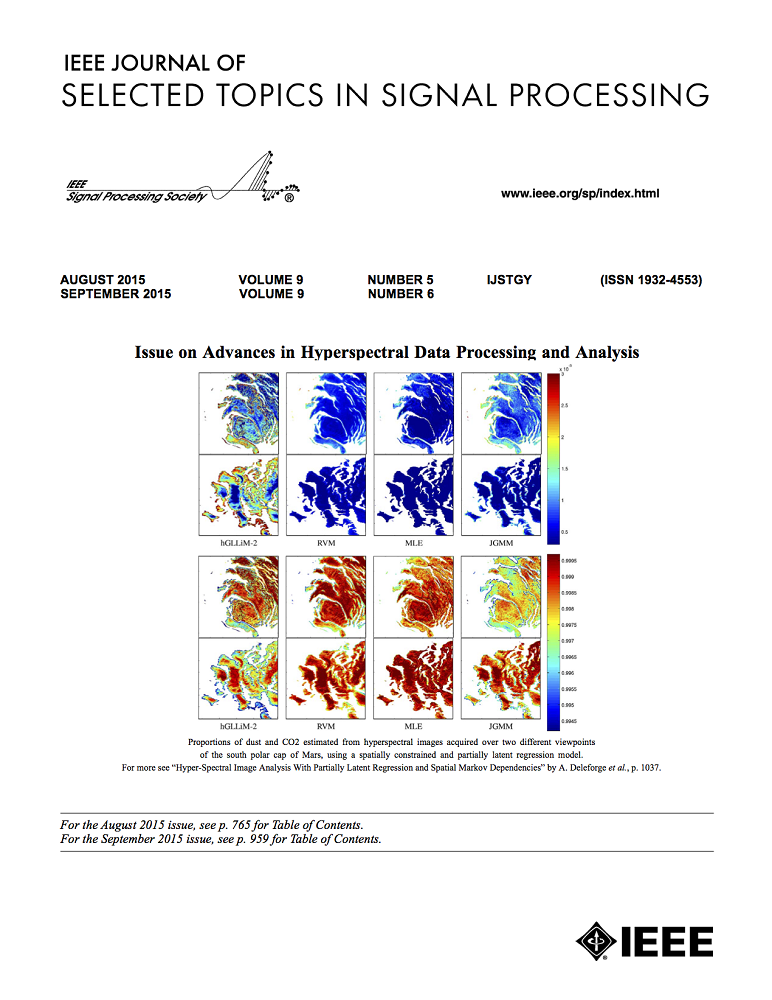Dual Driven Leaning for Joint Activity Detection and Channel Estimation in Multibeam LEO Satellite Communications
IF 8.7
1区 工程技术
Q1 ENGINEERING, ELECTRICAL & ELECTRONIC
IEEE Journal of Selected Topics in Signal Processing
Pub Date : 2024-09-13
DOI:10.1109/JSTSP.2024.3461308
引用次数: 0
Abstract
This paper investigates the uplink massive connectivity by grant-free random access in intelligent reflecting surface (IRS) assisted low earth orbit satellite communications. By leveraging sporadic activity of the ground devices (GDs), the joint device activity detection and channel estimation (JADCE) problem can be addressed by compressive sensing (CS) algorithms, which either fail to satisfy estimation accuracy or suffer from high computation complexities. Consequently, we propose a general data and model dual driven architecture to efficiently solve the JADCE problem through an unfolded iterative network. Specifically, we improve the original multiple-measurement-vectors (MMV) orthogonal approximate message passing (OAMP) algorithm with an unrolled model driven neural network to exploit the sparse beamspace channel. Moreover, we incorporate the data driven in each iteration, termed model and data dual driven OAMP network (DOAMPNet), which adaptively learns channel sparsity and improves channel estimation performance with model guarantees. Extensive simulations are provided to demonstrate the superiority of the proposed model and data dual driven networks compared with existing methods in terms of estimation accuracy. Remarkably, the proposed DOAMPNet reduces pilot overhead by about 40%, and achieves a normalized mean-square error improvement of about 4 dB when signal-to-noise ratio is 10 dB.多波束LEO卫星通信联合活动检测与信道估计的双驱动学习
研究了智能反射面(IRS)辅助低地球轨道卫星通信中无授权随机接入的上行海量连接问题。通过利用地面设备(GDs)的零星活动,压缩感知(CS)算法可以解决联合设备活动检测和信道估计(JADCE)问题,但压缩感知(CS)算法要么无法满足估计精度,要么计算复杂度高。因此,我们提出了一种通用的数据和模型双驱动架构,通过展开迭代网络有效地解决JADCE问题。具体来说,我们改进了原来的多测量向量(MMV)正交近似消息传递(OAMP)算法,利用展开模型驱动的神经网络来利用稀疏波束空间信道。此外,我们在每次迭代中加入数据驱动,称为模型和数据双驱动OAMP网络(DOAMPNet),该网络自适应学习信道稀疏性,并在模型保证的情况下提高信道估计性能。大量的仿真结果表明,与现有方法相比,所提出的模型和数据双驱动网络在估计精度方面具有优越性。值得注意的是,所提出的DOAMPNet减少了约40%的导频开销,并且在信噪比为10 dB时实现了约4 dB的归一化均方误差改善。
本文章由计算机程序翻译,如有差异,请以英文原文为准。
求助全文
约1分钟内获得全文
求助全文
来源期刊

IEEE Journal of Selected Topics in Signal Processing
工程技术-工程:电子与电气
CiteScore
19.00
自引率
1.30%
发文量
135
审稿时长
3 months
期刊介绍:
The IEEE Journal of Selected Topics in Signal Processing (JSTSP) focuses on the Field of Interest of the IEEE Signal Processing Society, which encompasses the theory and application of various signal processing techniques. These techniques include filtering, coding, transmitting, estimating, detecting, analyzing, recognizing, synthesizing, recording, and reproducing signals using digital or analog devices. The term "signal" covers a wide range of data types, including audio, video, speech, image, communication, geophysical, sonar, radar, medical, musical, and others.
The journal format allows for in-depth exploration of signal processing topics, enabling the Society to cover both established and emerging areas. This includes interdisciplinary fields such as biomedical engineering and language processing, as well as areas not traditionally associated with engineering.
 求助内容:
求助内容: 应助结果提醒方式:
应助结果提醒方式:


